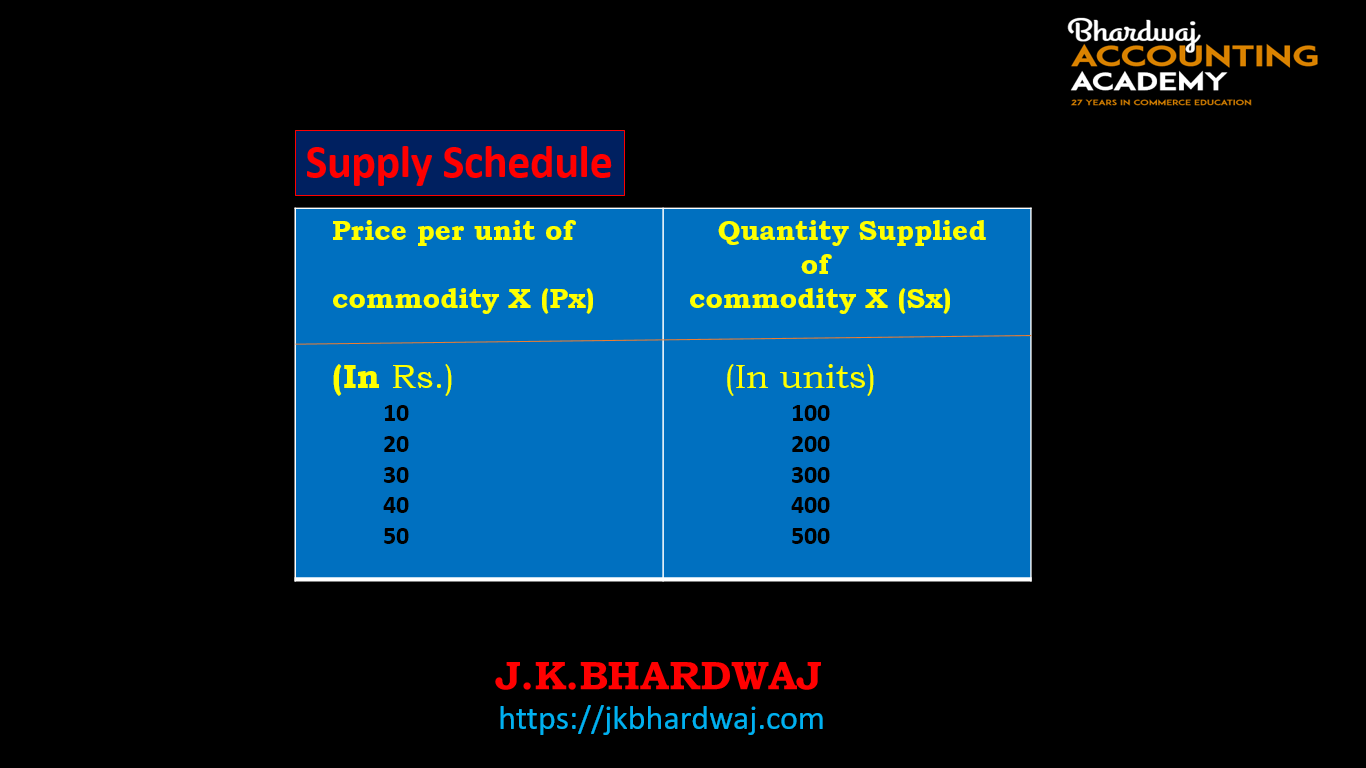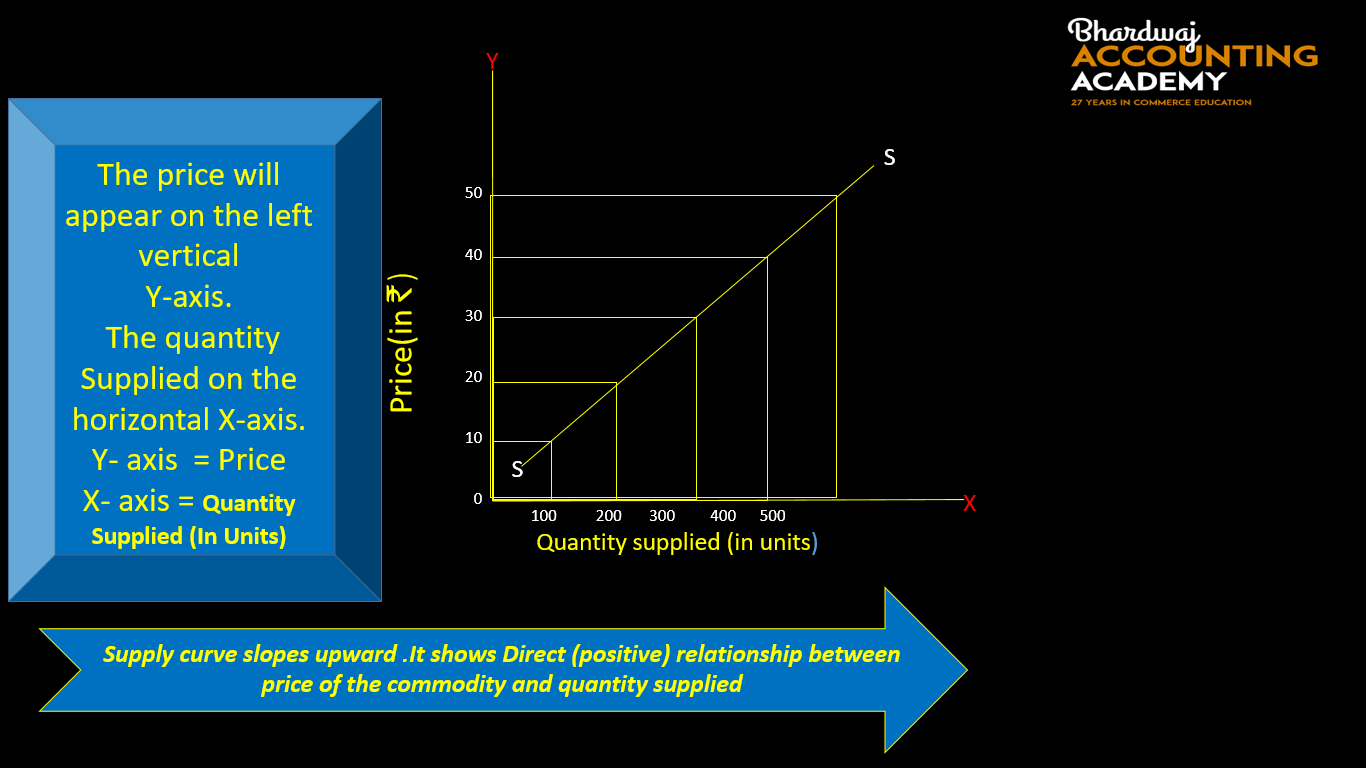Table of Contents
Law Of Supply
The law of supply states the direct (positive) relationship between price of the commodity and quantity supplied of a commodity , keeping other factors constant.
The law of supply refers to the direction in which quantity supplied changes with a change in price. There is an direct relationship between quantity supplied and its price.
Definition of Law Of Supply
According to Dooley-“The law of supply states that other things being equal the higher the price, the greater the quantity supplied or the lower the price, the smaller the quantity supplied.“
According to Lipsey- “The law of supply states that other things being equal, the quantity of any commodity that firms will produce and offer for sale is positively related to the commodity’s own price, rising when price rises and falling when price falls.“
Thus we can say that, Law of Supply-states that the higher the price, greater the quantity supplied or lower the price, lesser the quantity supplied of a commodity, other determinants of supply remaining constant;
Thus, the supply curve of a commodity slopes upward from left to right.
ALSO READ : LAW OF DEMAND AND ASSUMPTIONS OF THE LAW OF DEMAND
Assumptions of the law of supply
Law of Supply depends on the basic assumption ‘other things remaining the same’ (or ceteris paribus is a Latin phrase that generally means “ all other things being equal”) Now let us see what we include in this phrase’ ‘ other things remaining the same’ they are:-
- No change in the state of technology.
- No change in the price of factors of production.
- No change in the number of firms in the market.
- No change in the goals of the firm.
- No change in the seller’s expectations regarding future prices.
- No change in the tax and subsidy policy of the products.
- No change in the price of other goods.
- No change in the Transport and Communication Conditions
ALSO READ : SUPPLY AND ITS DETERMINANTS/FACTORS AFFECTING SUPPLY
Law of supply can be explained with the help of example and diagram:-
The schedule and figure explain the law of supply. The schedule reveals that the rise in the price of the good from Re.10 to Rs. 20 leads to a rise in the supply of the good from 100 units to 200 units, respectively. The supply curve also depicts a positive slope, which implies that the supply of the good rises due to the rise in its price.
* Supply curve slopes upward from left to right.
* It shows positive relationship between the own price of the commodity and its quantity supplied: price rises, quantity supplied also rises.
Important facts about Law Of Supply
- Positive/Direct Relationship:
Law of Supply states the positive relationship between price of the commodity and quantity supplied of a commodity, assuming that no changes in other factors.
- Qualitative, not Quantitative:
Law of Supply makes a qualitative statement, as it indicates the direction of change in the quantity supplied, but it does not indicate the volume of change.
- No Proportional Relationship:
Law of Supply does not establish any proportional relationship between change in price and the resultant change in quantity supplied.
- One-Sided:
Law of supply is one sided as it only explains the effect of change in price on the quantity supplied.
Law of supply states nothing about the effect of change in quantity supplied on the price of the commodity.
Reasons for Law of Supply
Let us now try to understand, why the supply of a commodity expands as the price rises. The main reasons for operation of law of supply are:
- Profit Motive: The basic aim of producers, while supplying a commodity, is to secure maximum profits. When price of a commodity increases, without any change in costs, it raises their profits. So, producers increase the supply of the commodity by increasing the production. On the other hand, with fall in prices, supply also decreases as profit margin decreases at low prices.
- Change in Number of Firms: A rise in price induces the prospective producers to enter into the market to produce the given commodity so as to earn higher profits. Increase in number of firms raises the market supply. However, as the price starts falling, some firms which do not expect to earn any profits at a low price either stop the production or reduce it. It reduces the supply of the given commodity as the number of firms in the market decreases.
- Change in Stock: When the price of a good increases, the sellers are ready to supply more goods from their stocks. However, at a relatively lower price, the producers do not release big quantities from their stocks. They start increasing their inventories with a view that price may rise in near future.
Exceptions to the Law of Supply
There are some situations under which the law f supply does not operate. These situations may be treated as Exceptions to the Law of Supply. The important exceptions to the law of supply are-
-
Perishable Goods: Sellers of perishable goods (like fruits, vegetables, milk, fish) cannot hold onto their stock for long, regardless of price changes. They might be forced to sell them at lower prices to avoid losses from spoilage, even if prices are falling.
-
Agricultural Products: The supply of agricultural products is heavily dependent on natural factors like weather conditions, rainfall, and soil fertility. Even if prices rise, producers might not be able to increase supply significantly in the short run due to fixed growing seasons and limited land. Conversely, a good harvest might lead to a higher supply even if prices are not high.
-
Rare Goods / Artistic and Auction Goods: For unique or rare items (like antique coins, famous paintings, or limited edition collectibles), the supply is inherently fixed. An increase in price cannot lead to an increase in their supply, as no more can be produced.
-
Backward Bending Supply Curve of Labor: In the labor market, as wages increase, individuals initially tend to work more hours (substitution effect). However, beyond a certain point, very high wages might lead some individuals to prefer more leisure time over additional work, as they can achieve their income goals with fewer hours. This causes the labor supply curve to bend backward, meaning that at very high wage rates, the quantity of labor supplied may decrease.
-
Monopoly: In a monopoly, there is only one seller, who has significant control over the market and price. A monopolist may choose to restrict supply even if prices are rising, in order to maximize profits, rather than increasing supply to meet the higher price.
-
Need for Immediate Funds: If a seller is in urgent need of cash, they might sell goods at lower prices to clear inventory quickly, even if it’s not profitable, thus defying the law of supply.
-
Out-of-Fashion Goods: Sellers may offer “out-of-fashion” or outdated goods at very low prices to clear their stock, even if prices are generally low, as they would otherwise become unsalable.
8. Expectation of Future Prices: If sellers expect prices to fall in the near future, they might increase their current supply to sell off stock, even if current prices are low. Conversely, if they expect prices to rise, they might withhold supply to sell later at a higher price.
9.Government Policies/Legislation: Government interventions like production quotas, price controls, or export restrictions can limit the quantity that producers are allowed to supply, regardless of market prices.
-
Economic Slowdown/Business Closure: During an economic slowdown or when a business is on the verge of closure, sellers may sell goods at lower prices to recover costs and clear inventory, even if it means not following the typical supply-price relationship.
ALSO READ : LAW OF DEMAND AND ASSUMPTIONS OF THE LAW OF DEMAND


